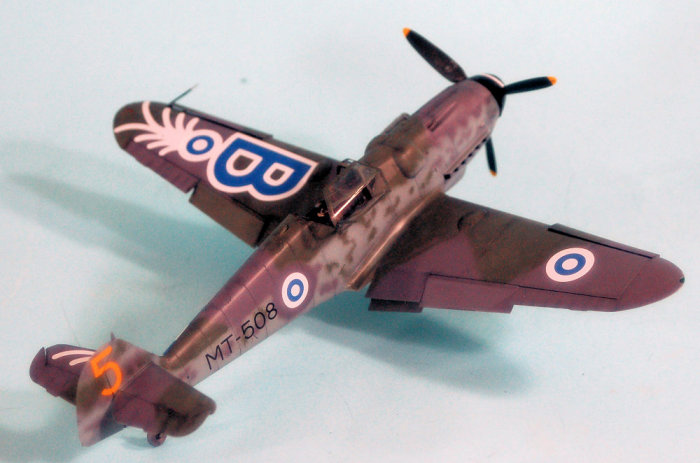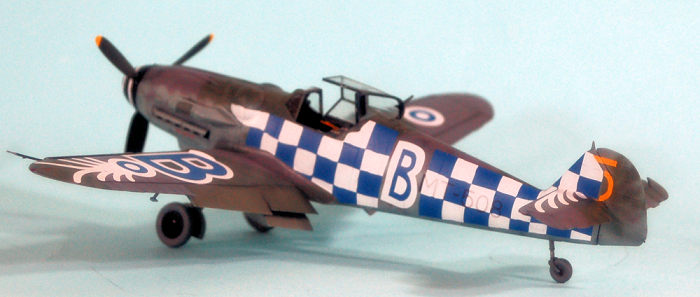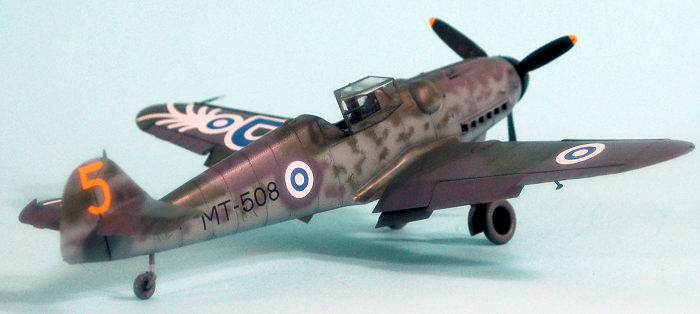
Eduard 1/48 Bf-109G-6 'Mersu'
| KIT #: | 11114 |
| PRICE: | $89.99 SRP |
| DECALS: | Ten options |
| REVIEWER: | Tom Cleaver |
| NOTES: | Double kit, contains one Bf-109G-2/G-4 and one Bf-109G-6. |

| HISTORY |
 The Finnish Air Force received the first Bf 109s in 1943. Forty-eight
Bf-109G-2s were purchased and the first arrived in Finland on 13 March 1943.
Beginning in late 1943, 109 Bf-109G-6s were delivered, with the last arriving on
20 Auigust 1944, just prior to the Finnish surrender in the Continuation War.
The Bf-109 was nicknamed “Mersu,” the same nickname for Mercedes-Benz cars,
whose parent company Daimler-Benz produced the Bf 109 engine.
The Finnish Air Force received the first Bf 109s in 1943. Forty-eight
Bf-109G-2s were purchased and the first arrived in Finland on 13 March 1943.
Beginning in late 1943, 109 Bf-109G-6s were delivered, with the last arriving on
20 Auigust 1944, just prior to the Finnish surrender in the Continuation War.
The Bf-109 was nicknamed “Mersu,” the same nickname for Mercedes-Benz cars,
whose parent company Daimler-Benz produced the Bf 109 engine.
During the Continuation War, Bf 109s were operated by HleLv (fighter squadron) 24, 28, 30 and 34. Finnish pilots scored a total 667 confirmed victories, with HleLv 34 being the top scorer with 345 victories while HleLv 24 scored 304. Total losses of Bf-109s in combat amounted to 18 in air combat and a further 16 to anti-aircraft fire. Operational accidents claimed another 16, with eight destroyed on the ground by enemy action, with a total of 23 pilots killed in combat or accidents.
At the end of the war, the Finns still had 102 Bf 109s in service, and the aircraft remained the main fighter of the Finnish Air Force for most of the next 10 years until Major Erkki Heinilä made the last flight of a Finnish 109 in MT-507 on 13 March 1954. Bf-109G-6 MT-452 was immaculately restored nearly 40 years ago and is on display at the airfield in Utti. MT-507, the last to fly, is on display at the Central Finland Aviation Museum in Helsinki.
| THE KIT |
Eduard did what no other company has done before when their 2012 release of the Bf-109G-6 turned out to be considerably less than promised as regarded accuracy. They went back and redesigned the kit and got it right, releasing it again in 2014. 2016 saw the release of the Bf-109G-2/G-4.
 This limited edition Dual Combo release provides complete kits of a
Bf-109G-2 and Bf-109G-6, with a beautiful decals sheet providing no less than 10
options for Finnish 109s, with both blue/white and the later “greyed-out”
swastika national insignias, and including two post-war airplanes. One of these
is a Bf-109G-6 flown by Lieutnant Arvo Arima of HleLv 31 in an “air race” held
on June 23, 1950, at Utti air base outside Helsinki. MT-508 was one of four
Bf-109s that flew a “Reno-style” pylon air race. The four airplanes had a very
colorful set of blue/white checkerboard markings painted on the left side of the
fuselage, with “bird feathers” painted on the left wing and left horizontal
stabilizer.
This limited edition Dual Combo release provides complete kits of a
Bf-109G-2 and Bf-109G-6, with a beautiful decals sheet providing no less than 10
options for Finnish 109s, with both blue/white and the later “greyed-out”
swastika national insignias, and including two post-war airplanes. One of these
is a Bf-109G-6 flown by Lieutnant Arvo Arima of HleLv 31 in an “air race” held
on June 23, 1950, at Utti air base outside Helsinki. MT-508 was one of four
Bf-109s that flew a “Reno-style” pylon air race. The four airplanes had a very
colorful set of blue/white checkerboard markings painted on the left side of the
fuselage, with “bird feathers” painted on the left wing and left horizontal
stabilizer.
| CONSTRUCTION |
 The Eduard 109G series presents no difficulties for a modeler willing to
commit the revolutionary act of actually following the instructions.
The Eduard 109G series presents no difficulties for a modeler willing to
commit the revolutionary act of actually following the instructions.
I started as usual with the cockpit, and used the very nice photo-etch set for the instrument panel and seat belts. I then assembled the fuselage and attached the “short” vertical fin. While that set up, I assembled the wing. I then brought the two sub-assemblies together and finished by attaching the horizontal stabilizers and the control surfaces.
| COLORS & MARKINGS |
 I followed the very complete paintings and markings guides provided by
Eduard to do the Bf-109G-6 “racer.” By camouflage pattern, this was an
MTT-Regensburg airplane, and I freehanded the RLM 74/75/76 camo.
I followed the very complete paintings and markings guides provided by
Eduard to do the Bf-109G-6 “racer.” By camouflage pattern, this was an
MTT-Regensburg airplane, and I freehanded the RLM 74/75/76 camo.
The decals are very good. They went on without difficulty. Once everything had set up, I washed the model to get rid of dried setting solution, then gave it an overall finish with clear flat varnish. I attached the landing gear and prop, unmasked the canopy and posed it in the open position.
| CONCLUSIONS |
 I think Eduard’s Bf-109G series of kits are the best out there of the
main 109 sub-type. With these Finnish markings, a modeler has a great choice of
several interesting airplanes to replicate. Any modeler with experience
assembling a plastic kit should be able to create a model they’ll be proud to
display with this kit. Take your time and follow the instructions and all will
be well.
I think Eduard’s Bf-109G series of kits are the best out there of the
main 109 sub-type. With these Finnish markings, a modeler has a great choice of
several interesting airplanes to replicate. Any modeler with experience
assembling a plastic kit should be able to create a model they’ll be proud to
display with this kit. Take your time and follow the instructions and all will
be well.
Tom
Cleaver 22 March
2018 Copyright Modeling Madness. com Review kit courtesy of Eduard. If you would like your product reviewed fairly and fairly quickly, please
contact
the editor
or see other details in the
Note to
Contributors.
Back to the Main Page
Back to the Review
Index Page
Back to the Previews Index Page